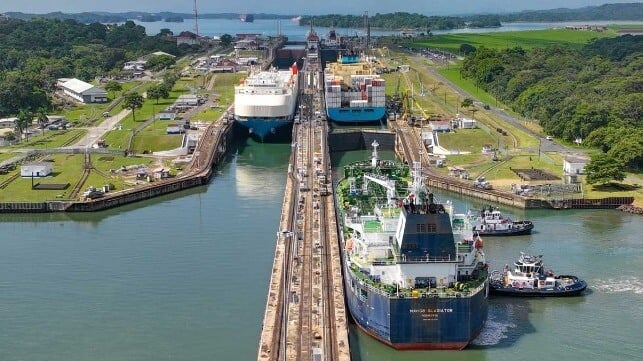Panama Canal to Add Back Daily Transits as Rainy Season Approaches

After months of increasing restrictions due to falling water levels in its reservoir, the Panama Canal Authority will continue its gradual restoration of daily transits and add a foot to the maximum draft. The decision was made after an analysis of the water levels, efforts to save water and increase storage, and a slight increase in rainfall levels in April ahead of the traditional rainy season.
The increase in transits is especially good news for bulkers, car carriers, and gas carriers as well as smaller containerships as the increases in transits are slated for the original Panamax locks. After a week-long period of maintenance in May that will restrict transits, the number of daily crossings will be increased primarily for the” Supers” category, Panamax vessels with a beam over 91 feet. Five slots will be restored for a total of 18 daily transits for Supers with a total of 31 daily transits being conducted.
Starting in June, the Panama Canal Authority will also add one additional slot for the largest vessels transiting the canal through the new Neopanamax locks. They will increase from seven to eight the number of vessels and as of mid-June also add one foot back to the maximum authorized draft. It will increase to 45 feet as of June 15, which while below the pre-draft levels which were as high as 50 feet, will still further reduce the challenges for the largest ships. Some containerships have been transshipping boxes across the isthmus to reduce their draft.
These moves come in advance of the rainy season which traditionally runs from May to December in Panama. Last year, the Panama Canal Authority reported a significant decline in rainfall resulting in the driest October since 1950. The authority had mapped a strategy that could have seen transits fall to a lower of 18 per day but they were able to cap the restrictions at 22 daily transits.
Shipping lines have managed during the restrictions as the authority encouraged more use of reservations to reduce waiting times. Some ships diverted around South America, but the routings were complicated by the problems in the Red Sea which forced further diversions. Today, the Panama Canal reports that 30 vessels with reservations are in the queue for transit and just 11 without reservations are waiting. The numbers peaked at over 100 vessels in the queue in late 2023 and now the average waiting time is down to between just over one and two and a half days for vessels without reservations.
In an advisory to customers, the authority wrote that it plans to continue to further ease the restrictions based on the success of its water conservation efforts and expected rainfall. They hope to return to the level of 36 to 39 daily transits and be back to “normalized operations” by 2025.
Last week, the government of Panama reported that it was also taking long-term steps to enable further overland transport of cargo. Called the Multimodal Dry Canal project, they said they would employ existing roads, railways, port facilities, airports, and duty-free zones to create a new "special customs jurisdiction" to provide a dry route as an alternative to the water bridge.

that matters most
Get the latest maritime news delivered to your inbox daily.
Maersk at the beginning of 2024 formalized a similar service. The shipping company broke its Pacific route into two loops at Panama with containers traveling overland between the vessels on the Atlantic and the Pacific. The company recently announced as of mid-May it would restore the single ship routing eliminating the need to move containers overland.
As Panama struggled to manage the impact of the drought, both Mexico and Honduras sought to increase competition. Both countries outlined plans for overland rail service to move containers coming from Asia to the United States.
